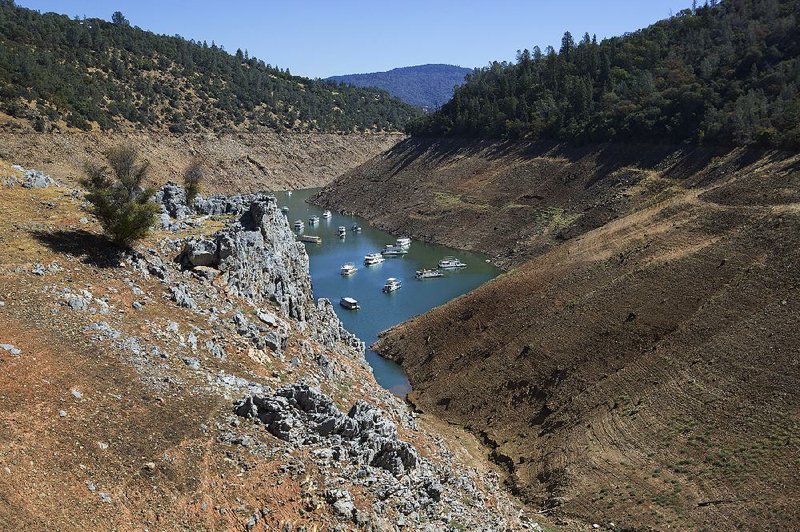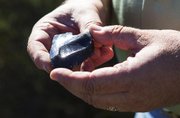CLEARLAKE, Calif. -- Along cracked-mud shorelines and beneath tangles of weeds on parched riverbanks, artifacts and archaeological sites that have rested in peace beneath the water for hundreds and even thousands of years have become increasingly visible as the state's drought has lingered, leaving them susceptible to plunder by looters.
Although archaeological pillaging is age-old, the receding waters of the state's lakes, rivers and reservoirs have lent special urgency, exposing the remains of a lost California, and alarming archaeologists, historians and especially American Indians whose ancestral grounds are increasingly vulnerable to thieves bearing picks and shovels.
In recent months, a man was arrested twice for looting at Anderson Marsh State Historic Park, where archaeological deposits date back 13,000 years or more. The initial arrest was made by Lake County detective Richard Kreutzer, who had recently completed a class on identifying archaeological crimes.
Even he was shocked by what was hidden in the suspect's van: more than two dozen obsidian spear points, early stone hunting tools, a clay pottery bowl and other Indian artifacts, some with index cards specifying the depth of the soil in which they were found.
"These sites are naked," said Leslie Steidl, a state park archaeologist. She supervises a legion of volunteers who look out for looters, supplementing surveillance cameras along key trails.
For tribal members like Dino Beltran, treasurer of the Koi Nation of Northern California, the lands around Anderson Marsh are sacred, and the antiquities cloistered among the turtles and great blue herons are his legacy. His great-great-grandfather and other family members were born on an island in the lake.
"These artifacts represent our ancestors and the sacrifices they made for us to be here," he said of the recent thefts. "For them to be disrespected is a terrible thing."
The city of Clearlake, slightly more than 100 miles north of San Francisco, was named for its ancient lake, home to the indigenous Pomo people who settled there some 14,000 years ago. The tribes have weathered displacement, violence and intergenerational trauma.
The looting of Indian sites is particularly egregious given the history, said John Parker, an archaeologist who led efforts to save Anderson Marsh. "All people need a sense of stability, to know where they came from," he said. "This is particularly important for people whose culture was disrupted."
Gregory White, a California archaeologist, has called the basin around Clear Lake "one of the most important records of human habitation in the West," abundant with obsidian that was used for making dart points and other tools. Artifacts procured during the last major drought, in 1977, frequently show up at flea markets and relics shows, White said.
In the United States alone, there is a brisk market for prime objects. A 10,000- to 15,000-year-old Clovis point can fetch as much as $250,000, an obsidian dart point $250.
"There's a trophy mentality among collectors," said Martin McAllister, a forensic archaeologist.
The ability of looters to deploy Google Earth, social media and other tools has created new challenges for enforcement officials. Selling online has become relatively easy, with one arrowhead sales site noting that droughts can create perfect conditions for "blowout hunting."
Vandalizing more than $950 worth of artifacts or removing material from Indian burial sites is a felony under California law. But Todd Swain, a special agent for the National Park Service, said that on the vast federal lands in the West, only 13 percent of looting cases are solved, and most wind up being prosecuted as misdemeanors. "The deterrent effect is practically zero," he said.
Beltran, who started a tribal consortium two years ago to protect archaeological sites from real estate development, said he considers looting an "everyday occurrence" that preceded the drought, although the recent exposure of artifacts has raised the stakes. The Koi and another tribe helped sponsor an archaeological crimes class with the sheriff's office, the one that Kreutzer took.
Clear Lake is one of many sites being pillaged as the region -- still steeped in drought -- waits eagerly for rains that are expected to come in January. At the Lake Oroville reservoir in the Sierra Nevada foothills, about a two-hour drive from Clear Lake, newly exposed archaeological sites are scattered across 167 miles of receding shoreline.
The lake's complex heritage spans prehistoric times to the Gold Rush era from rock mortars used by the Konku Maidu peoples for grinding acorns to the remains of miners' taverns that until recently were submerged.
Mark Selverston, an archaeologist who has extensively surveyed the area, recently pointed out square-cut forged iron nails, shards of Chinese stoneware, the tip of a handblown glass medicine bottle and numerous signs of looting -- churned-up earth with discards piled on nearby rocks. "If these sites are gone, then the way to interpret them is also gone," he said. "They're a common trust."
Nevertheless, last year at Lake Oroville, a 67-year-old looter was caught with pockets full of artifacts at a site that is typically underwater. After he was arrested, the authorities discovered some 2,000 arrowheads, stone tools and other objects at his home, which they said were booty from a 20-year looting spree.
"It was a hobby," said Kurt Worley, the Butte County supervising district attorney. "Unfortunately it was a hobby that was destructive to cultural and natural resources."
To Steidl, the state park archaeologist, the acquisitive lust for artifacts has echoes of the gold rush. "It's a reminder of what greed does and how it can change a landscape," she said.
SundayMonday on 12/06/2015


